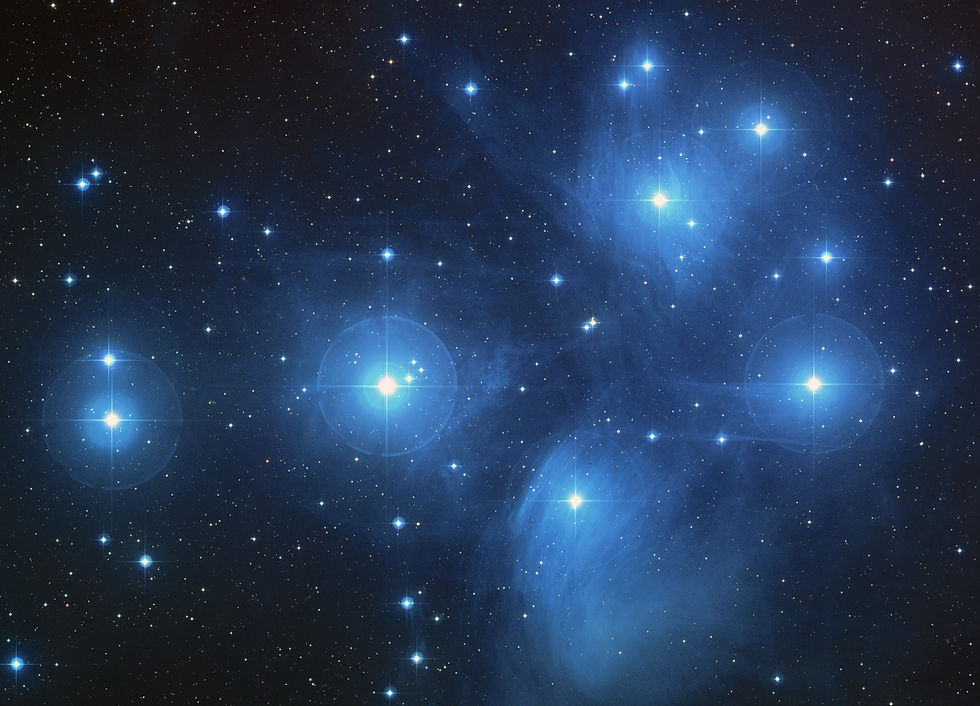The 7 Sisters do not want to get Sirius with Orion!
- Luke

- Feb 4, 2021
- 4 min read
Updated: Mar 12, 2021

In the south-east sky is a whole Greek romantic drama playing out this February. The legend that goes; Orion has taken a lustful interest in the Seven Sisters and has Chosen to pursue them. However, the Seven Sisters have no interest in Orion so they pleaded to Zeus (or sometimes it's Jupiter, Jupiter is the Roman equivalent of the Greek god Zeus) to protect them. Zeus/Jupiter placed Taurus the bull (which can be made out by it’s bright red eye Aldebaran) between Orion and the Seven Sisters. As the night goes on you can watch the Seven Sisters run away west followed by their protector Taurus, and pursued by Orion. In turn Orion is backed up by his trusty dogs Canis Major of which the bright star Sirius is the dog tag and Canis Minor of which the (a little less bright) bright star Procyon is the dog tag.

High in the south-east sky you should be seeing the iconic constellation of Orion. Orion and the Big Dipper I would say are the most iconic constellations of the northern sky. Orion I would say is even more iconic globally as you can see it in the southern hemisphere too. Actually when I worked in Australia they thought the big dipper was Orion (there is few places you can rarely see the actual Big Dipper in Australia) Australians sometimes call Orion the "saucepan" or the "shopping trolley" and you can imagine how if you looked at Orion upside down (as they do in Australia) you can make a dipper shape where the belt is the base of the saucepan and the sword is the handle.

The actual Big Dipper is low in our north-east sky currently but since I went into detail about the Big Dipper recently (#7 and #8 here) let's focus in on Orion.

Just within the sword of Orion (the 3 stars hanging at a diagonal from Orion's belt) is Orion’s nebula this can easily be seen in decent binoculars as a cloudiness around the star and in a good telescope you will be able to see some of the structure of the nebula. Pictured below is a hubble image of the Orion Nebula which shows more detail and color than possible to see with the human eye. They make these vivid color pictures of nebulae by taking pictures in the ultra violet (more purple than the human eye can see) and infer red (more red than the eye can see and painting them in as reds and purples as if you could see them. It's called a "false color" image when they do this and sounds like cheating but it is still representative of scientific data even if the color isn't really real. This nebula is a star forming region, or stellar nursery where you will see baby stars which were just formed littered across the nebula.

Just below Orion is the constellation Canis Major (or "the big dog"). Canis Major is most known for, and recognized most by the brightest star in our night sky, Sirius. Rising low in the south-east you will see this bright star and possibly mistake it for an airplane or something else bright at first. I say brightest in our “night” sky because of course the sun is a star and by a large margin the brightest one in our sky. So, I like to give the sun credit, life really wouldn't be the same without it.

The name Sirius comes from Greek meaning scorching as it has been the brightest star in the night sky for all of written history. On occasion you might hear hot days referred to as “dog days” this actually comes from Sirius the “dog” star and dates back to ancient Egypt. When Sirius was seen rising in the morning with the sun it was the hottest days and coincided with the flooding of the Nile. because of this Egyptians would watch for it in the mornings to know to prepare for the coming floods. It was thought that the sun and Sirius shining together is what made the heat and because Sirius was in the big dog in the sky it was natural to call it a “dog day”. you can still use this as a seasonal indicator as here we are still in winter and you can see that Sirius is currently on almost the opposite side of the sky from the Sun.

Just above Orion (up and to the west from Orion) is the Seven Sisters. The Seven Sisters look like a little smattering of stars (sometimes confused with the little dipper, as they kind of have a dipper shape too) almost directly over head. If you are able to see all seven you have exceptional vision; most people can only see six with the naked eye. However in binoculars (or a telescope) you will actually be able to see hundreds. This is called an “open cluster” and is the next step after the infant stars in the Orion nebula. These are teenage stars leaving their nursery and going their own way in the galaxy.

We are starting to get back to our normal tours book one today to see all these things in my large telescopes! It's the perfect date idea for a Covid safe valentines date. And if you're feeling unlucky in love like Orion we have a Match.com event March 5th for you to find love under the stars!
Also Happy New Year! I have made two 2021 calendars! One with star charts and info so you can keep stargazing all year long no mater where you are and learn the night sky for 2021 buy it here. One with phenomenal space pictures each month buy it here. Both can be shipped anywhere and make great gifts! Learn more about both calendars here.


.png)



Comments